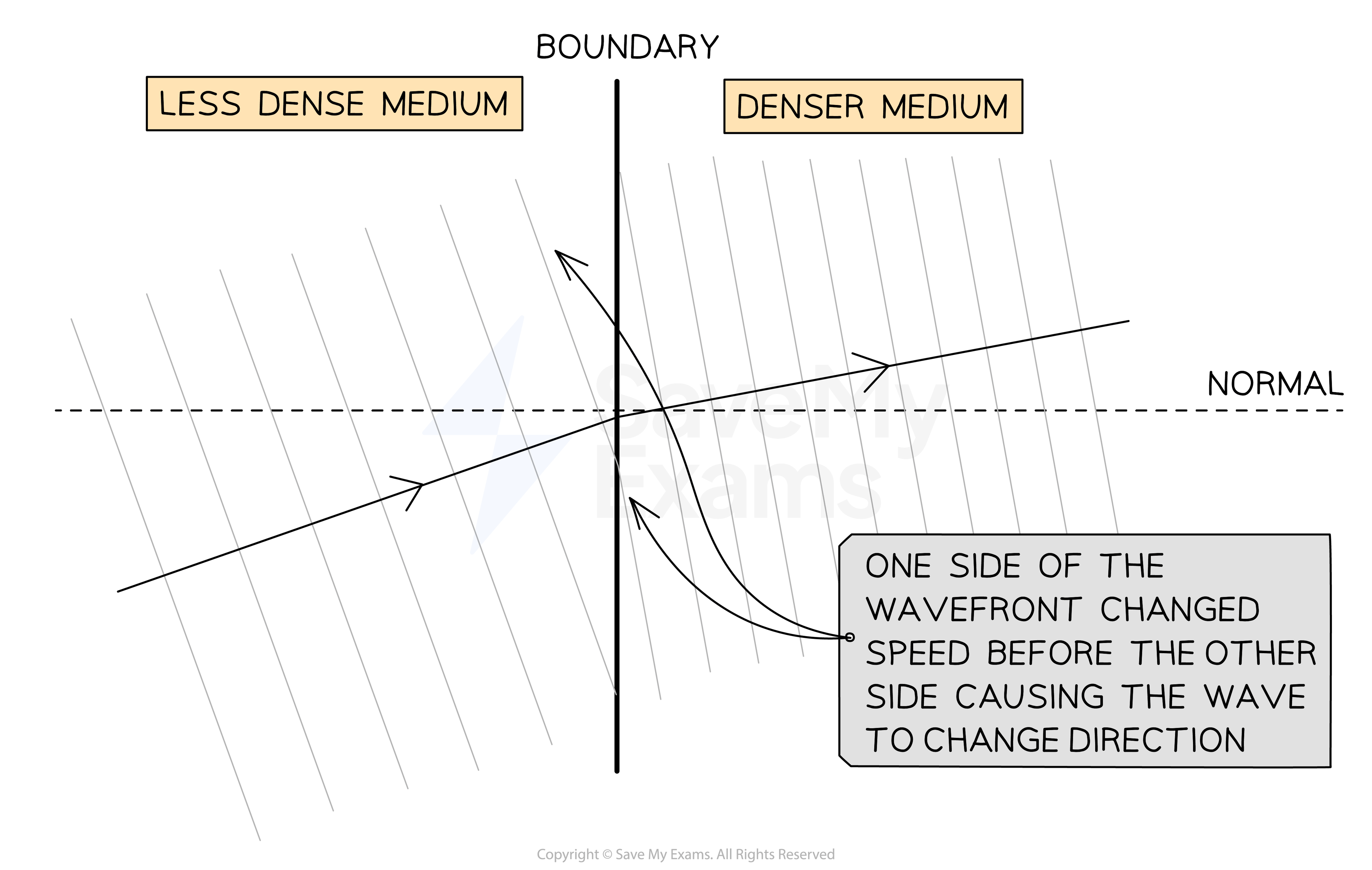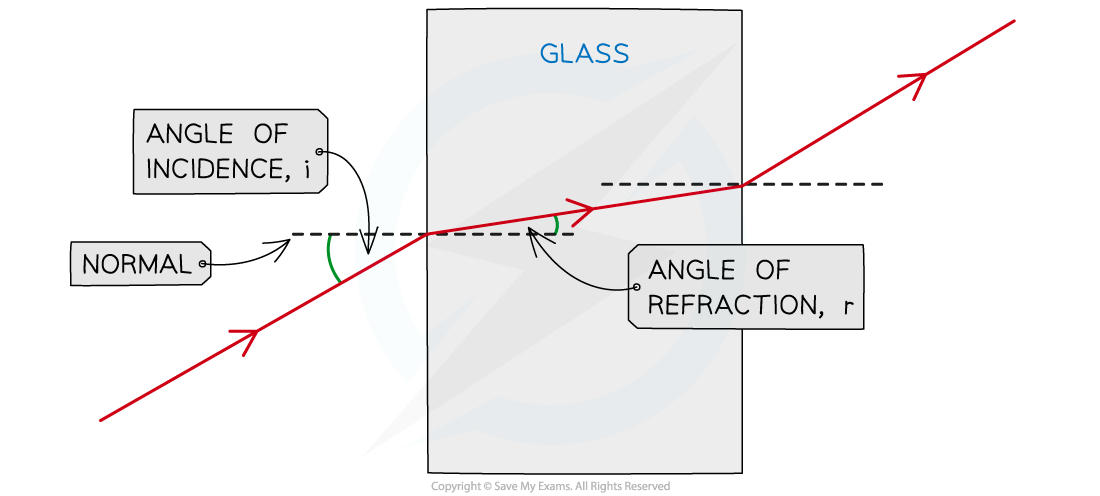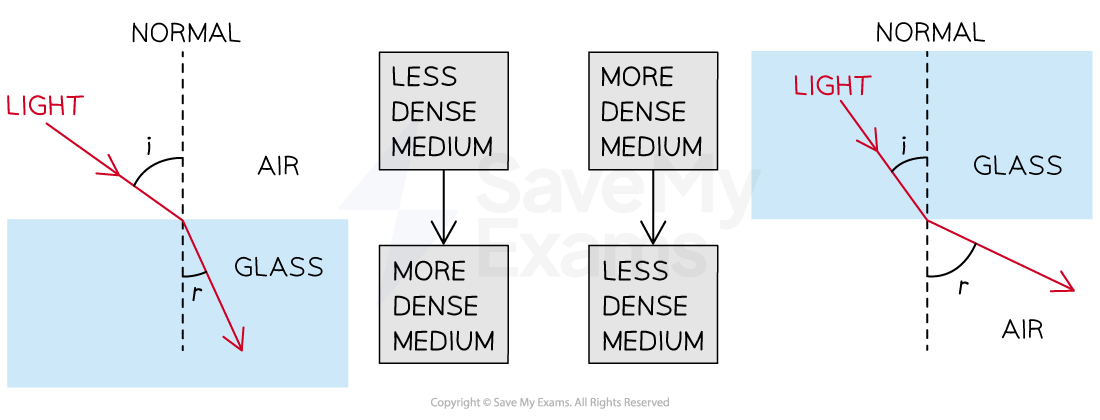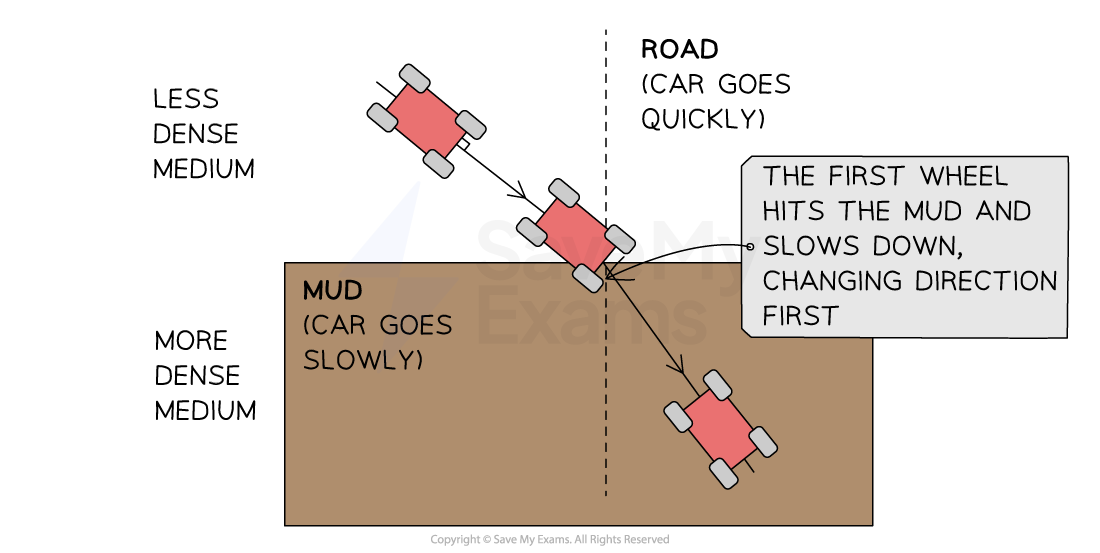Reflection, Refraction & Transmission (DP IB Physics) : Revision Note
Reflection, Refraction & Transmission
When waves arrive at a boundary between two materials, they can be:
Reflected
Refracted
Transmitted
Absorbed
In optics, a transparent material is called a medium
When referring to more than one medium these are called media
Reflection
Reflection occurs when:
A wave hits a boundary between two media and does not pass through, but instead bounces back to the original medium
The law of reflection states:
The angle of incidence, i = The angle of reflection, r

Reflection of a wave at a boundary
When a wave is reflected, some of it may also be absorbed or transmitted through the medium
At a boundary between two media, the incident ray is the ray that travels towards the boundary
During reflection, the frequency, wavelength and speed of the wave does not change
Refraction
Refraction is:
The change in direction of a wave when it passes through a boundary between mediums of different density
This change of direction is caused by a change in the speed of different parts of the wavefront as they hit the boundary
In optics, the word medium is used to describe a transparent material

A wavefront changes direction when part of it hits a boundary and changes speed before the other parts
Conditions for refraction
When a wave travels from a less dense medium into a denser medium:
The more optically dense the medium
The slower the waves travel
The smaller the angle of refraction
The light bends towards the normal
When a wave travels from a denser medium into a less dense medium:
The less optically dense the medium
The faster the waves travel
The greater the angle of refraction
The light bends away from the normal
The amount of refraction that takes place is determined by the difference between the angles of incidence (i) and refraction (r) of the waves at the boundary
The angles of incidence and refraction are measured from the normal line
This is drawn at 90° to the boundary between the two media

The angle of incidence is the angle between the approaching incident ray and the normal. The angle of refraction is the angle between the ray leaving the boundary and the normal.
The amount of change in direction that takes place depends on the difference in optical density between the two media
When light passes from a less dense medium to a more dense medium, (e.g. air → glass):
The refracted light has a lower speed and a shorter wavelength than the incident light
When light passes from a more dense medium to a less dense medium (e.g. glass → air):
The refracted light has a higher speed and a longer wavelength than the incident light
When a wave refracts, its speed and wavelength change, but its frequency remains the same
This is noticeable by the fact that the colour of the wave does not change

When light passes from a less to a more dense material the ray refracts towards the normal
When the light ray is incident on the boundary at 90°:
The wave passes straight through without a change in direction
This is because the whole wavefront enters the boundary at the same time at the same speed

Light travelling along the normal to the boundary between material 1 and material 2
Refraction of Water Waves
Refraction can also occur between materials of different depths
You may be asked to explain the behaviour of water waves when they refract between deep and shallow areas
When waves pass from deep to shallow water there is more friction between the sea bed and the wave and less space for the wave to oscillate so the waves:
Slow down
The wavelength of the wave decreases
So the distance between wave peaks is reduced
Angle of refraction is less than angle of incidence, r < i
If the waves hit the boundary between the change in depth at an angle then they refract towards the normal
So the angle of refraction < angle of incidence

When water waves travel from deep areas to shallow areas they slow down
Transmission
Transmission occurs when:
A wave passes through a substance
Refraction is a type of transmission
Transmission is the more general term for a wave appearing on the opposite side of a boundary (the opposite of reflection)
Refraction is specifically the change in direction of a wave when it crosses a boundary between two materials that have a different density
When passing through a material, waves can be partially absorbed
The transmitted wave will have a lower amplitude if some absorption has occurred

When a wave passes through a boundary it may be absorbed and transmitted
During transmission, the frequency or speed of the wave does not change
Reflection, refraction and transmission occur for all types of waves, both transverse and longitudinal
Examiner Tips and Tricks
You must be able to differentiate between the different types of wave behaviour. Refraction and reflection is commonly mixed up. With refraction, there is always transmission and a change in direction in another medium. With reflection however, there is no transmission into another medium.
It can be tricky to understand the concept of refraction. Imagine a car driving at an angle from a road and onto a patch of mud. The wheel that hits the mud will slow down first whilst the second wheel continues to travel at the initial speed. This causes the car to turn.

In many situations in refraction, there are two boundaries to consider, the refracted ray from boundary 1 is the incident ray at boundary 2. Don't get confused with your notation in this situation. Label your diagram clearly to help.

You've read 0 of your 5 free revision notes this week
Sign up now. It’s free!
Did this page help you?
